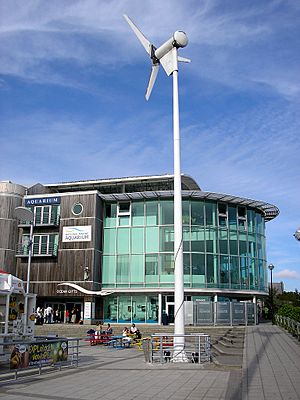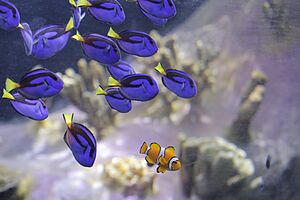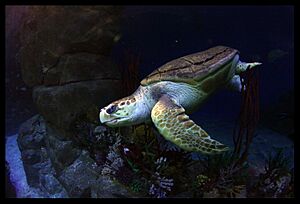National Marine Aquarium, Plymouth facts for kids

Entrance to the National Marine Aquarium
|
|
| Date opened | 1998 |
|---|---|
| Location | Plymouth, England |
| Coordinates | 50°22′00″N 4°07′53″W / 50.3666°N 4.1313°W |
| No. of animals | 4,000 |
| No. of species | 400 |
| Volume of largest tank | 2,500,000 L (660,000 US gal) |
| Memberships | BIAZA |
| Major exhibits | 4 main zones |
The National Marine Aquarium in Plymouth, England, is the biggest aquarium in the UK. It's home to over 4,000 amazing sea creatures! It also does important work to protect our oceans and teaches people of all ages about marine life.
Imagine seeing sharks, turtles, and jellyfish up close! You can even spot fish that look like characters from Finding Nemo. One of the coolest parts is the huge Great Barrier Reef exhibit. It holds 650,000 litres of water and is filled with some of the ocean's most colourful fish!
The aquarium is also home to the Ocean Conservation Trust. This charity helps people connect with the ocean and understand why it's so important to protect it. The aquarium opened in May 1998. It focuses on research, education, and conservation. It is also part of the British and Irish Association of Zoos and Aquariums (BIAZA).
Exploring the Aquarium's Zones
The National Marine Aquarium is split into four main areas. These are the Plymouth Sound, British Coasts, Atlantic Ocean, and Blue Planet zones. Your visit will take you on a journey from the waters around Plymouth to the famous Great Barrier Reef in Australia.
Discovering Plymouth Sound
This zone shows you the marine life found right around Plymouth. It highlights the many different habitats in the area. There are 17 tanks here, including a rock pool and a wave tank. They are home to about 80 types of fish and invertebrates. You can see local sharks, rays, seahorses, and even octopuses.
Exploring British Coasts
The second exhibit is the largest collection of native British sea life. As you move through this zone, you can learn about renewable energy from our oceans. This area also has life-size models of whales and dolphins found around Britain.
The Eddystone Reef Tank
The large Eddystone tank shows creatures from the Eddystone reef. This reef is about 19 km south of Plymouth. Through a huge window, you can see many different animals. Look for conger eels, mullet, pollack, and bream swimming freely. Smooth hound sharks also glide through the open water. On the seabed, you might spot flatfish and rays hiding. Lobsters and crabs like to hide among the rocks.
Journey to the Atlantic Ocean
This zone has several exciting areas. These include 'Ocean Drifters', 'Ocean Lab', 'Observation Deck', 'Lost at Sea', and 'Ocean Predators'.
Ocean Drifters: Jellyfish Wonders
The 'Ocean Drifters' exhibit opened in 2009. It features amazing jellyfish like moon jellies and Japanese sea nettles. You can also see Upside-down jellyfish. These delicate creatures live in special round tanks. This design keeps them safe from harm.
The Giant Atlantic Tank
The other areas in this zone surround the aquarium's largest tank. It holds 2.5 million litres of water! This huge tank is home to 1,000 Caribbean fish. You can see nurse sharks, lemon sharks, and sand tiger sharks. Other amazing animals include zebra sharks, sandbar sharks, and barracudas. Look out for southern stingrays, tarpon, and even turtles. This exhibit was updated in 2009 with a huge shipment of fish from Barbados. It was updated again in 2015/16 with new lemon and sand-tiger sharks.
Behind the Scenes: The Laboratory
The Laboratory lets you see what it's like to work at the aquarium. You can watch biologists caring for young sea creatures. They raise these animals before they move into the main exhibits. This care is very important for the species. It helps them grow and get ready for an ecosystem that suits their natural life.
Exploring the Blue Planet
This zone includes the 'Biozone' and the 'Great Barrier Reef'.
Biozone: Ocean Diversity
Biozone shows off the amazing variety of life in the world's oceans. Here you can see unique creatures like longhorn cowfish and lionfish. It's also home to the Giant Pacific Octopus (Enteroctopus dofleini) and different types of seahorses.
The Great Barrier Reef Grand Finale
The Great Barrier Reef exhibit is the grand ending to your visit. It's the second largest tank at 700,000 litres. It is also the most colourful! This reef is home to over 70 species of fish. It was once home to Snorkel, a loggerhead sea turtle. Snorkel lived at the aquarium from 1990 to 2016.
Ocean Conservation Efforts
The National Marine Aquarium is a charity that works hard to protect our oceans. They do this by helping people learn about marine life. In 2004, they led a project to sink the frigate HMS Scylla. This created an artificial reef in Whitsand Bay, Cornwall.
The aquarium is also a main partner in "Just Add H2O". This is a learning centre for schools. They also offer outreach programs that teach 30,000 school children each year. These programs follow the National Curriculum. The National Marine Aquarium also gives grants to smaller charities. This helps them further marine conservation efforts.
Images for kids










